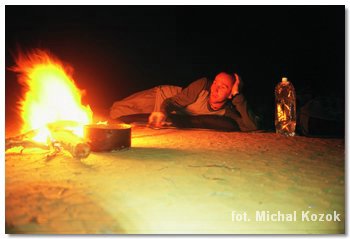Equipment |
Food |
Equipment food
Eating is a very personal matter, it is difficult to recommend anything. For the backpacking trip I don’t carry food almost at all, as I rely on the local cuisine. I usually don’t have any stomach problems, and street food is cheap and tasty.
However, situation changes if we are talking about trekking. There we need to carry the food keeping in mind the amount, taste, price, weight and method of preparation.
 If I have access to the shops during the trekking, I can stock up on bread, dairy products, fruit, etc, I would take advantage on it (tasty and I don’t have to carry it). But when I'm in remote areas, my feeding system during long-distance hiking looks something like this:
If I have access to the shops during the trekking, I can stock up on bread, dairy products, fruit, etc, I would take advantage on it (tasty and I don’t have to carry it). But when I'm in remote areas, my feeding system during long-distance hiking looks something like this:
I get up at the morning, I pack a camp and hit the road, without any food or drink. The hike is warming me up, I walk until I start feeling hunger. It usually takes one to two hours. Then I’m taking a break combined with the breakfast. I don’t belong to people who eat a lot at morning, I don’t need a cup of hot tea, so this break is easy to organize (without setting up a stove). In the desert excursions I’m taking a protein-carbohydrate drink called the Optimizer from Endura company (there are many companies producing similar stuff, I chose what I have around me). Such a drink improves and maintains muscle tissue, and provides glycogen and electrolytes replenishment. The drink itself is usually not enough for a breakfast, so from that point until lunch I eat occasionally the following snacks: canned fish or meat if I have bread (the beginning of the adventure), muesli and protein bars, nuts (all except peanuts as they have poor nutritional value), chocolate (Nutella), dried fruits.
I have usually a quick lunch, sometimes just boiling water for instant soup, or similar dish with dried pasta. In the dessert I eat bars, nuts, etc. After the lunch I do siesta accompanied with short nap.
In the evening I usually have the biggest power to walk. One of the nicest moments of the day is the decision to set up a camp. When the tent is pitched, I start making fireplace or setting up stove and prepare the main meal. The best energy value to weight ratio have hermetically sealed, freeze-dried meals (also called dehydrated food). They are packed about 100-200 grams, poured together with 250-500ml hot water, it gives about 400-800 calories of energy,  costs from €6. It’s difficult to recommend any particular company, as the market is full of different manufacturers, and personal tastes and habits dramatically different from each other. I like meat meals with pasta or rice. In Australia I use Back Country Cuisine. Just ask the local outdoor shop what they have in offer and try what is available. In addition to taste, I suggest to have a look on nutritional value information. Compare the energy, carbohydrates, protein, fat and some minerals. Generally, such dish poured with boiling water is ready to eat in a few minutes.
costs from €6. It’s difficult to recommend any particular company, as the market is full of different manufacturers, and personal tastes and habits dramatically different from each other. I like meat meals with pasta or rice. In Australia I use Back Country Cuisine. Just ask the local outdoor shop what they have in offer and try what is available. In addition to taste, I suggest to have a look on nutritional value information. Compare the energy, carbohydrates, protein, fat and some minerals. Generally, such dish poured with boiling water is ready to eat in a few minutes.
Fortunately Ewelina is working harder than me, so when we go hiking together we have a greater variety of food. She prepares different meals, but my favourite one is pasta with tuna in the sauce.
Sometimes in the desert I bake bread at evening. I carry the flour and I need lots of wood, as for two hours high temperature is required. After this time I pull out aluminium foil from the sand, and inside is a fresh, warm wholemeal loaf.
I also carry multivitamins with me, which are supplements of all the necessary vitamins and minerals in my body. One capsule a day can help to stay fit.